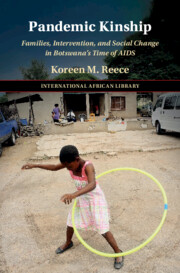Book contents
- Pandemic Kinship
- The International African Library
- Pandemic Kinship
- Copyright page
- Dedication
- Contents
- Figures
- Acknowledgements
- Characters
- Introduction
- Part I ‘Where Are You From? Where Are You Going?’
- Part II ‘Who Is Taking Care of Your Things?’
- Part III ‘We Are Seeing Things’
- Part IV ‘They Were Far Family’
- Part V ‘We Show People We Are Together’
- Conclusion
- An Epidemic Epilogue
- Glossary of Setswana Terms
- Bibliography
- Index
- Titles in the Series
- References
Bibliography
Published online by Cambridge University Press: 16 June 2022
- Pandemic Kinship
- The International African Library
- Pandemic Kinship
- Copyright page
- Dedication
- Contents
- Figures
- Acknowledgements
- Characters
- Introduction
- Part I ‘Where Are You From? Where Are You Going?’
- Part II ‘Who Is Taking Care of Your Things?’
- Part III ‘We Are Seeing Things’
- Part IV ‘They Were Far Family’
- Part V ‘We Show People We Are Together’
- Conclusion
- An Epidemic Epilogue
- Glossary of Setswana Terms
- Bibliography
- Index
- Titles in the Series
- References
Summary
- Type
- Chapter
- Information
- Pandemic KinshipFamilies, Intervention, and Social Change in Botswana's Time of AIDS, pp. 284 - 301Publisher: Cambridge University PressPrint publication year: 2022
- Creative Commons
- This content is Open Access and distributed under the terms of the Creative Commons Attribution licence CC-BY-NC-ND 4.0 https://creativecommons.org/cclicenses/



